
Alfred Hitchcock
Joel Gunz’s excellent posts on his about Alfred Hitchcock, and the artistic works from which he drew inspiration, have made me ponder my own influences. Hitchcock’s films have been fundamental touchstones for my creative development –particularly the way in which he uses his films to explore modern man’s psyche in the mid-twentieth century (I was born in 1955 at the height of his power as a filmmaker).
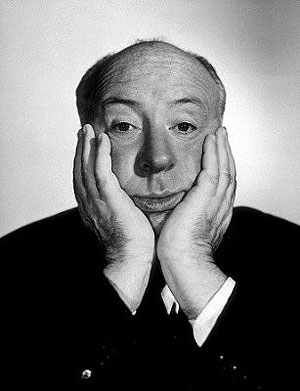 Alfred Hitchcock
Alfred HitchcockFrom my viewpoint, Hitchcock was always a little disingenuous in letting people believe that he was just an entertainer. From early in his career he was using film to examine human behaviour in a way that was as sophisticated as any psychologist. Some of the themes are explicit (Spellbound, Under Capricorn, Vertigo, Marnie). Others are more disguised, hidden under the surface of the mystery and the entertainment values.
Andrew Sarris wrote in his review of Psycho,
Even Hitchcock films that are considered lighter entertainment — like North By Northwest — can be analyzed for their insightful examination of human behaviour. After all, what is the journey of Roger Thornhill (played by Cary Grant), if not the journey of a man towards self-realization?
In his essay on North By Northwest, Steven Patterson writes,
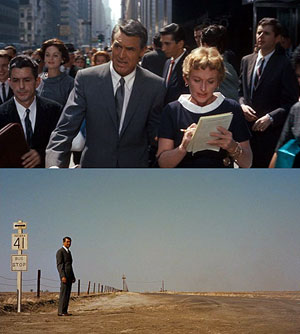 North By Northwest, 1959, dir. Alfred Hitchcock
North By Northwest, 1959, dir. Alfred HitchcockI’ve long been drawn to Carl Jung’s ideas about psychic development. Jung writes,
Hitchcock’s films are peopled with those who pretend to be one thing and yet, through the crucible of experience, are shown to be something else. I’m particularly struck by the multiple ways in which Hitchcock visually explains this to us.
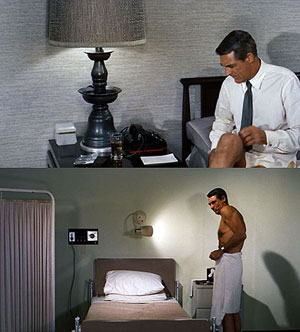 North By Northwest, 1959, dir. Alfred Hitchcock
North By Northwest, 1959, dir. Alfred HitchcockThornhill is shown at the beginning of the film in an elegant business suit, in a position of authority, surrounded by people, as he exits a building on Madison Avenue. Compare this with the shots of him standing in the open on the mid-western plains, without the trappings of success and autonomy (he has no mode of transport once he gets off the bus.) Who exactly is he at this point? Does it matter in the slightest that he’s a successful Madison Avenue executive? That fact is meaningless –it won’t save him. It’s only his primitive desire to survive, and his own internal resources — his willingness to be courageous in the face of attack – that’s his salvation.
He’s furthermore literally stripped, throughout the film, of his clothes as the events unfold. To my mind, this is a visual way of indicating how he’s stripped down to an essence that’s without definition, and then a new awareness is able to arise within him. This awareness transforms his personality. North By Northwestis essentially the hero’s journey.
The climactic chase on Mount Rushmore becomes a heroic statement of a new, more authentic identity — contextualized by the faces of American men with big ideas.
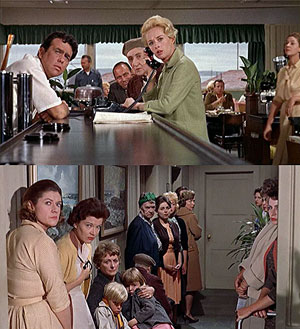 The Birds (1963), dir. Alfred Hitchcock
The Birds (1963), dir. Alfred HitchcockThe Birds is another film that strikes me as worthy of contemplation on a psychological level. Its metaphors are very powerful. As far as I’m aware, Hitchcock never explained the movie, but it was made at the height of the cold war and I think that this fact informs its themes (I remember that when the movie came out my dad was talking about building a bomb shelter in our backyard). Among other ideas, the bird attacks can be seen as a metaphor for nuclear war, for that for which we are unprepared, and for that which is beyond our ability to comprehend.
To be sure, the movie is remembered for the dramatic bird attacks, but it’s also full of images, without the birds, that suggest the character of the American psyche at a particular point in time — one of paranoia and suspicion (that, quite frankly, persists to this day). It suggests a society that’s frightened, and one that lets its fear run it.
The diner scene is one of my favourite scenes in the film, because it dissects the typical American suspicion of the other. Each of the characters in the diner represent various archetypes, and the scene is reminiscent of those diner interviews that one sees on cable news channels, where people seem convinced that Iraq is behind 9/11.
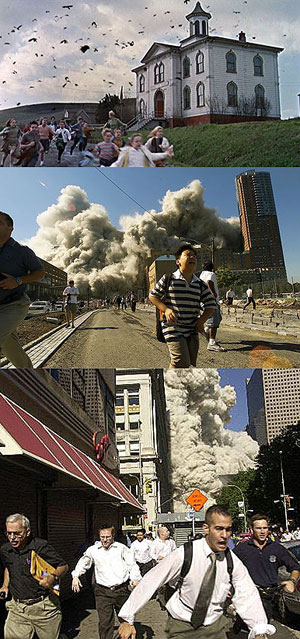 The Birds (1963), dir. Alfred Hitchcock, and substituting birds for terrorist attacks
The Birds (1963), dir. Alfred Hitchcock, and substituting birds for terrorist attacksOne of the reasons the film still resonates is that it’s as topical today as it was then. Just substitute terrorism for bird attacks, and then take a look at the shots throughout the film of people reacting.
On a more specific level, there’s also the theme of an arrested adolescence. Mitch Brenner (played by Rod Taylor) is a man who still lives with his mother, unable to commit to a relationship. Again, the challenge of the experience forces him to come out from under the shadow of his father and to separate himself from the mother so that he might be able to be a man in his own right.
The way that Hitchcock positions his actors in the frame is no mistake. Mitch Brenner is framed under his father’s portrait, and his mother is frequently framed between him and Melanie Daniels. As he rises to the occasion of fending off the birds — by implication, becoming his own man — the positioning changes. Melanie stands between him and his mother, and the mother becomes smaller in the frame.
If one thinks about the film from this point of view, there’s something very courageous and hopeful about the final shot of the movie — we see a group of people, finally united, in a positive way, and moving into the unknown, into the very middle of that which scares them. They’re scared but they’re brave and willing to face what comes. The sun is even breaking through the clouds in the distance.
As a metaphor for psychological processes, it’s very dynamic—it’s only by facing our fears that we overcome them. I always thought that it was indicative of one’s own state of mind as to whether one found this final shot hopeful or despairing. I’m in the hopeful camp.
SOURCES:
[1] Remembering Andrew Sarris: A Great American Film Critic
[2] Four Archetypes: (From Vol. 9, Part 1 of the Collected Works of C. G. Jung) by Sonu Shamdasani, C. G. Jung and R. F.C. Hull (2010) Princeton University Press
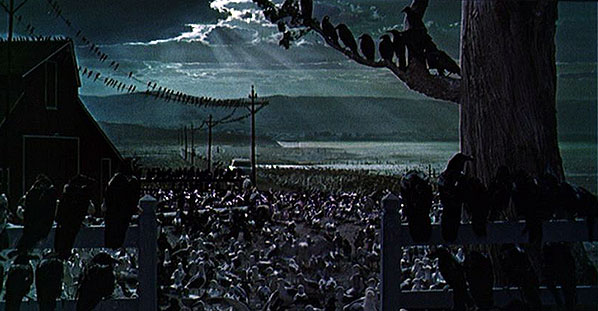

Norman Buckley
Norman is a television director and editor known for his work on shows such as Pretty Little Liars, Gossip Girl, The Lying Game, Melrose Place, 90210, Chuck and The OC. He currently teaches part-time at UCLA, in addition to editing and directing.
You can find more of Norman’s work at his website and blog, and he’s on Twitter too – @norbuck.
© 2022 STATIC MASS EMPORIUM . All Rights Reserved. Powered by METATEMPUS | creative.timeless.personal. | DISCLAIMER, TERMS & CONDITIONS
HOME | ABOUT | CONTACT | TWITTER | GOOGLE+ | FACEBOOK | TUMBLR | YOUTUBE | RSS FEED
CINEMA REVIEWS | BLU-RAY & DVD | THE EMPORIUM | DOCUMENTARIES | WORLD CINEMA | CULT MOVIES | INDIAN CINEMA | EARLY CINEMA
MOVIE CLASSICS | DECONSTRUCTING CINEMA | SOUNDTRACKS | INTERVIEWS | THE DIRECTOR’S CHAIR | JAPANESE CINEMA





